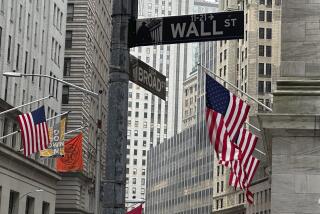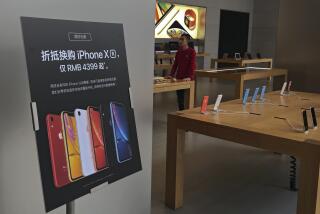Apple yields to investor pressure with decision to pay dividends
It wasn’t as breathlessly awaited as the latest iPad or iPhone, but investors may come to appreciate the iDividend just as much.
Investors have been clamoring for Apple Inc. to begin making quarterly payouts as the tech giant’s stock price has doubled since June and its cash hoard neared $100 billion. The announcement Monday illustrates the importance that investors place on dividends — especially during times of market uncertainty.
Pressure from shareholders has prompted American companies to boost dividend payments at a record pace in the last few years, and experts say the trend will continue.
“The dividend component is so incredibly important for investors,” said Diane Jaffee, manager of the TCW Dividend Focused fund. “Investors of all stripes — individuals and institutions — really want that comfort.”
Companies in the S&P 500 index are on pace to shell out a record $277 billion in dividends this year, up from the previous high of $248 billion in 2008, said Howard Silverblatt, senior index analyst at Standard & Poor’s in New York.
Dividends fell out of favor in the last three decades as stock prices rocketed higher in a succession of bull markets. Corporate America argued that the payouts were tax-inefficient, and that investors could benefit more if companies boosted stock prices by plowing their cash into research, acquisitions and share buybacks.
That thinking changed abruptly in the punishing bear market from 2007 to 2009. Record low interest rates on government bonds and bank deposits also have stirred interest as American savers cast about for investments paying even modestly higher yields.
At the peak in 1980, 469 companies in the S&P 500 stock index paid dividends. That fell to 351 in 2002 and is now up to 398.
“This is the second coming of dividends,” Silverblatt said.
But it hasn’t come easily.
S&P 500 companies are paying out only about 30% of their total earnings in dividends, far lower than the 52% average over the last 77 years, according to Silverblatt.
And the index’s dividend yield, a measure of the payout in relation to stock price, is only 2.14%, also low by historic standards though not far from the 2.38% yield on the 10-year Treasury bond.
Investors have pressured companies to boost or initiate dividends, especially technology companies that traditionally have been averse to parting with their cash. Apple had been a focal point given the multibillion-dollar cash pile it had built up.
“This company has had their door beaten on by investors saying, ‘It’s an unconscionable amount of money you’ve got on your balance sheet,’” Jaffee said.
The reluctance among tech companies stems partially from fear of being seen as middle-aged, or at least nearing that mark, and not having enough money for research during lulls in product cycles. Shares of Microsoft Corp., for example, have basically flat-lined since the company initiated its dividend in 2003.
But a company such as Intel Corp. still spends heavily on research, Jaffee said. It has paid a dividend since 1992.
The timing may have been coincidental given the tear that Apple has been on, but its stock price closed above $600 for the first time Monday. It rose $15.53, or 2.7%, to a 52-week high of $601.10.
Apple said it would make quarterly payments of $2.65 a share, starting in its fiscal fourth quarter beginning July 1. It said the payouts will total more than $10 billion a year.
The company’s dividend ratio would be 1.8%, identical to the average in the tech sector, while its 30% payout ratio would match that of the S&P 500, Silverblatt said.
The tech colossus also will launch a three-year share buyback program.
The dividend could give a short-term boost to Apple shares by making them appealing to a broader swath of investors — primarily aging baby boomers who need steady income in their retirement years. Some dividend-focused mutual funds, the big rage this year, are likely to scoop up Apple shares.
And though it may seem blasphemous in financial and technology circles, the dividend also could lighten any drop in Apple shares if the company’s remarkable run of success were to slow.
Even before Monday’s announcement, Apple’s stock had surged 45% this year. Some money managers point out that what had been a dramatic run-up in the stock in the last two years — it was at $85 at the end of 2008 — has turned parabolic this year, raising the risk in holding the stock.






